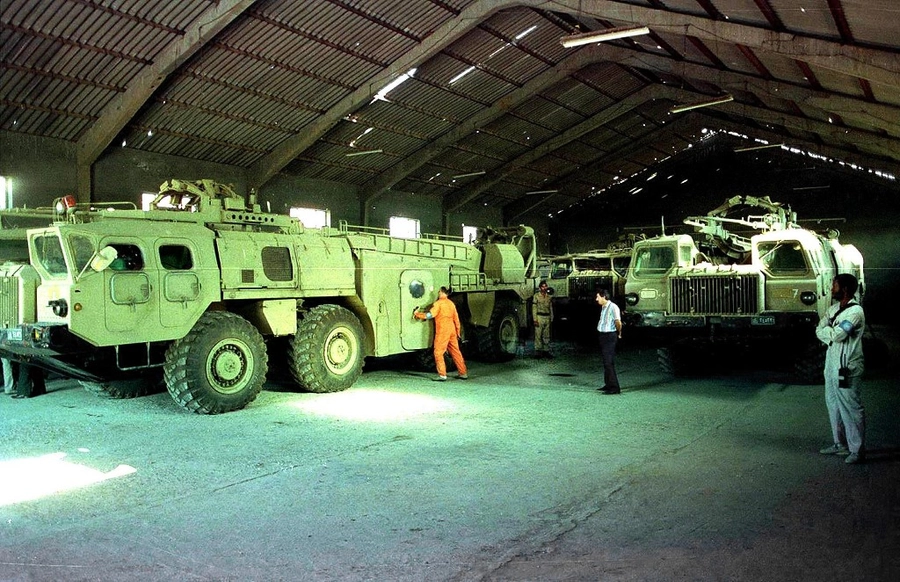The Kremlin in the past 72 hours has hit Ukraine with its most intensive barrage of ballistic missiles since the first days of the full-scale war, and by intensity, the pace of the Russian long-range attacks is comparable with Iraq’s bombardment of Saudi Arabia with Scud missiles during the 1991 Gulf War, according to official Ukrainian military reports.
Ukraine’s air defense troops taking on Moscow’s onslaught also may have set a new world one-day record for shooting down ballistic missiles, unconfirmed data recently published by Ukraine’s Army General Staff (AGS) and other state agencies showed.
According to Ukrainian military statements, on Monday, Dec. 11 air defense units stationed around Kyiv knocked down eight Russia-launched ballistic missiles and at least 16 kamikaze drones. In past months Kremlin strike planners had, instead of ballistic missiles, used a mix of cruise missiles and drones to attack Ukrainian homes and businesses.
The common definition of a ballistic missile is a rocket engine-powered weapon that is launched in a parabolic, high arc nearing the edge of the Earth’s atmosphere before flying down to its target and assisted by gravity accelerating to hypersonic speeds nearly six times the speed of sound.
In contrast with a motorcycle-sized kamikaze drone or a torpedo-sized cruise missile most used by the Kremlin in strikes against Ukraine in 2023, a Russian Iskander-M ballistic missile weighs about four tons and is longer than a city bus.

Update on Russia’s ‘Massive’ Overnight Electric Grid Attack
On Wednesday, Kyiv claimed it shot down ten Russian ballistic missiles aimed at the Ukrainian capital. Two usually reliable independent sources, the military journalist Andriy Tsaplienko and the war information platform Geoconfirmed identified the Kremlin strike package as a mix of low-accuracy S-300 missiles, a weapon also used for air defense, and modern, high-accuracy Iksander-M missiles.
Russian military information channels widely reported that Iskander-M missiles were the primary weapon used in the Monday and Wednesday strikes. When fired at ground targets both missiles fly a ballistic, high-arc path.
UNSCOM inspectors in charge of disarming Iraq, checking Iraqi Al Hussein-Scud launchers, before their destruction at an unspecified location in Iraq. PHOTO: AFP
Russia’s nuclear-capable Iskander missile (NATO code name SS-26 Stone) is carried on an eight-wheel truck and according to manufacturer advertising its primary weapon is a ballistic missile with a maximum range of 620 km and carrying 480-780 kg. of high explosives in its warhead, depending on the model.
The truck is also designed to launch a cruise missile but, in the Russo-Ukraine War, the ballistic missile has been more frequently used.
The most intense Russian ballistic missile bombardment of Ukraine probably took place in the early days of the invasion in Feb. 2022, with the launch of more than 100 medium-range missiles at targets across the country.
The onslaught using a significant portion of Russia’s ballistic missiles was part of an unsuccessful campaign to force regime change in Ukraine with shock and awe tactics. Since then, launches of more than four ballistic missiles by Russian forces have been rare.
According to the information platform militarytoday.com, during the 1991 Gulf War Iraq launched 83 ballistic missiles at targets in Saudi Arabia and Israel, almost all Scud missiles, a Soviet-era forerunner of the modern Russian Iskander. The US Army fired 150 Patriot missiles during the 43-day conflict and knocked down 45 incoming Scuds.
The Patriot system used by American forces at the time, called a PAC-1, was an early model variant designed primarily to intercept airplanes not ballistic missiles.
Patriot systems operated by the Armed Forces of Ukraine (AFU) are reportedly a more modern PAC-3 model with improved electronics and upgrades to increase the chances of a successful ballistic missile intercept.
The AFU reportedly fields two Patriot systems, one from the US and one from Germany. A modern French-Italian missile called SAMP/T rounds out Ukraine’s arsenal of top-level, fully modern long-range air defense systems.
According to recent news reports, a second Germany-donated Patriot system recently arrived in Ukraine but it’s not clear if it’s yet been deployed.
A spokesperson of the German Luftwaffe just confirmed to me that Germany has indeed delivered the second Patriot battery to #Ukraine.
— German Aid to Ukraine 🇩🇪🤝🇺🇦 (@deaidua) December 13, 2023
In October, Chancellor Scholz pledged a second Patriot battery to Ukraine. The training of UA personnel ended early December.
The now delivered… pic.twitter.com/4OxA7bWNn1
The first known successful intercept of a ballistic missile in combat, a Patriot shootdown of an Iraqi Scud missile aimed at a target in Saudi Arabia, took place on Jan. 17, 1991.
According to some sources the single most successful day of ballistic missile intercepts in history was Jan. 20, 1991, when Iraq fired ten Scud missiles at Saudi Arabia and coalition forces shot down nine, the tenth reportedly falling into the sea.
The Ukrainian Wednesday claim is ten ballistic missiles shot down in a day.
In the Monday strike against Kyiv, a man was hit by shrapnel and three women were treated for stress suffered from debris falling near their homes.
On Wednesday falling debris from multiple shot down Russian missiles injured 53 people and 4 severely, Ukrainian official statements said.
You can also highlight the text and press Ctrl + Enter







Comments (0)